ArcDrain: A GIS Add-In for Automated Determination of Surface Runoff in Urban Catchments
Abstract
:1. Introduction
2. Materials and Methods
2.1. ArcDrain Settings
2.2. Catchment Delineation
2.3. Data Combination
2.4. Peak Runoff Calculation
2.4.1. Rainfall Intensity
2.4.2. Runoff Coefficient
2.4.3. Uniformity Coefficient in the Temporal Distribution of Precipitation
3. Results and Discussion
4. Conclusions
Author Contributions
Funding
Institutional Review Board Statement
Informed Consent Statement
Data Availability Statement
Acknowledgments
Conflicts of Interest
References
- Aksha, S.K.; Resler, L.M.; Juran, L.; Carstensen, L.W. A Geospatial Analysis of Multi-Hazard Risk in Dharan, Nepal. Geomat. Nat. Hazards Risk 2020, 11, 88–111. [Google Scholar] [CrossRef] [Green Version]
- Ragia, L.; Antoniou, V. Making Smart Cities Resilient to Climate Change by Mitigating Natural Hazard Impacts. ISPRS Int. J. Geo-Inf. 2020, 9, 153. [Google Scholar] [CrossRef] [Green Version]
- CRED & UNDRR. 2020: The Non-COVID Year in Disasters; CRED: Brussels, Belgium, 2021. [Google Scholar]
- Ahiablame, L.; Shakya, R. Modeling Flood Reduction Effects of Low Impact Development at a Watershed Scale. J. Environ. Manag. 2016, 171, 81–91. [Google Scholar] [CrossRef]
- Hong, H.; Tsangaratos, P.; Ilia, I.; Liu, J.; Zhu, A.-X.; Chen, W. Application of Fuzzy Weight of Evidence and Data Mining Techniques in Construction of Flood Susceptibility Map of Poyang County, China. Sci. Total Environ. 2018, 625, 575–588. [Google Scholar] [CrossRef]
- Jato-Espino, D.; Lobo, A.; Ascorbe-Salcedo, A. Urban Flood Risk Mapping Using an Optimised Additive Weighting Methodology Based on Open Data. J. Flood Risk Manag. 2019, 12, e12533. [Google Scholar] [CrossRef] [Green Version]
- Liu, Q.; Yang, H.; Liu, M.; Sun, R.; Zhang, J. An Integrated Flood Risk Assessment Model for Cities Located in the Transitional Zone between Taihang Mountains and North China Plain: A Case Study in Shijiazhuang, Hebei, China. Atmosphere 2019, 10, 104. [Google Scholar] [CrossRef] [Green Version]
- Bandi, A.S.; Meshapam, S.; Deva, P. A Geospatial Approach to Flash Flood Hazard Mapping in the City of Warangal, Telangana, India. Environ. Socio Econ. Stud. 2019, 7, 1–13. [Google Scholar] [CrossRef] [Green Version]
- Hammami, S.; Zouhri, L.; Souissi, D.; Souei, A.; Zghibi, A.; Marzougui, A.; Dlala, M. Application of the GIS Based Multi-Criteria Decision Analysis and Analytical Hierarchy Process (AHP) in the Flood Susceptibility Mapping (Tunisia). Arab. J. Geosci. 2019, 12. [Google Scholar] [CrossRef]
- Mukherjee, F.; Singh, D. Detecting Flood Prone Areas in Harris County: A GIS Based Analysis. GeoJournal 2020, 85, 647–663. [Google Scholar] [CrossRef]
- Souissi, D.; Zouhri, L.; Hammami, S.; Msaddek, M.H.; Zghibi, A.; Dlala, M. GIS-Based MCDM–AHP Modeling for Flood Susceptibility Mapping of Arid Areas, Southeastern Tunisia. Geocarto Int. 2020, 35, 991–1017. [Google Scholar] [CrossRef]
- Ogato, G.S.; Bantider, A.; Abebe, K.; Geneletti, D. Geographic Information System (GIS)-Based Multicriteria Analysis of Flooding Hazard and Risk in Ambo Town and Its Watershed, West Shoa Zone, Oromia Regional State, Ethiopia. J. Hydrol. Reg. Stud. 2020, 27, 100659. [Google Scholar] [CrossRef]
- Wang, Y.; Hong, H.; Chen, W.; Li, S.; Pamučar, D.; Gigović, L.; Drobnjak, S.; Bui, D.T.; Duan, H. A Hybrid GIS Multi-Criteria Decision-Making Method for Flood Susceptibility Mapping at Shangyou, China. Remote Sens. 2019, 11, 62. [Google Scholar] [CrossRef] [Green Version]
- Jato-Espino, D.; Charlesworth, S.M.; Bayon, J.R.; Warwick, F. Rainfall-Runoff Simulations to Assess the Potential of Suds for Mitigating Flooding in Highly Urbanized Catchments. Int. J. Environ. Res. Public Health 2016, 13, 149. [Google Scholar] [CrossRef] [PubMed]
- Allende-Prieto, C.; Méndez-Fernández, B.I.; Sañudo-Fontaneda, L.A.; Charlesworth, S.M. Development of a Geospatial Data-Based Methodology for Stormwater Management in Urban Areas Using Freely-Available Software. Int. J. Environ. Res. Public Health 2018, 15, 1703. [Google Scholar] [CrossRef] [Green Version]
- Niyazi, B.A.; Masoud, M.H.; Ahmed, M.; Basahi, J.M.; Rashed, M.A. Runoff Assessment and Modeling in Arid Regions by Integration of Watershed and Hydrologic Models with GIS Techniques. J. Afr. Earth Sci. 2020, 172, 103966. [Google Scholar] [CrossRef]
- El-Fakharany, M.A.; Mansour, N.M. Morphometric Analysis and Flash Floods Hazards Assessment for Wadi Al Aawag Drainage Basins, Southwest Sinai, Egypt. Environ. Earth Sci. 2021, 80, 168. [Google Scholar] [CrossRef]
- Patil, N.S.; Nataraja, M. Effect of Land Use Land Cover Changes on Runoff Using Hydrological Model: A Case Study in Hiranyakeshi Watershed. Modeling Earth Syst. Environ. 2020, 6, 2345–2357. [Google Scholar] [CrossRef]
- Kalogeropoulos, K.; Stathopoulos, N.; Psarogiannis, A.; Pissias, E.; Louka, P.; Petropoulos, G.P.; Chalkias, C. An Integrated GIS-Hydro Modeling Methodology for Surface Runoff Exploitation via Small-Scale Reservoirs. Water 2020, 12, 3182. [Google Scholar] [CrossRef]
- Pariartha, G.; Goonetilleke, A.; Egodawatta, P.; Mirfenderesk, H. The prediction of flood damage in coastal urban areas. In Proceedings of the IOP Conference Series: Earth and Environmental Science, Bali, Indonesia, 29–30 August 2019; Institute of Physics Publishing: Bristol, UK, 2020; Volume 419. [Google Scholar]
- Yin, D.; Evans, B.; Wang, Q.; Chen, Z.; Jia, H.; Chen, A.S.; Fu, G.; Ahmad, S.; Leng, L. Integrated 1D and 2D Model for Better Assessing Runoff Quantity Control of Low Impact Development Facilities on Community Scale. Sci. Total Environ. 2020, 720, 137630. [Google Scholar] [CrossRef]
- Courty, L.G.; Pedrozo-Acuña, A.; Bates, P.D. Itzï (Version 17.1): An Open-Source, Distributed GIS Model for Dynamic Flood Simulation. Geosci. Model. Dev. 2017, 10, 1835–1847. [Google Scholar] [CrossRef] [Green Version]
- Peterson, E.E.; Pearse, A.R. IDW-Plus: An ArcGIS Toolset for Calculating Spatially Explicit Watershed Attributes for Survey Sites. J. Am. Water Resour. Assoc. 2017, 53, 1241–1249. [Google Scholar] [CrossRef] [Green Version]
- Jamali, B.; Löwe, R.; Bach, P.M.; Urich, C.; Arnbjerg-Nielsen, K.; Deletic, A. A Rapid Urban Flood Inundation and Damage Assessment Model. J. Hydrol. 2018, 564, 1085–1098. [Google Scholar] [CrossRef]
- Rezazadeh Helmi, N.; Verbeiren, B.; Wirion, C.; van Griensven, A.; Weerasinghe, I.; Bauwens, W. WetSpa-Urban: An Adapted Version of WetSpa-Python, A Suitable Tool for Detailed Runoff Calculation in Urban Areas. Water 2019, 11, 2460. [Google Scholar] [CrossRef] [Green Version]
- Akhter, M.S.; Hewa, G.A. The Use of PCSWMM for Assessing the Impacts of Land Use Changes on Hydrological Responses and Performance of WSUD in Managing the Impacts at Myponga Catchment, South Australia. Water 2016, 8, 511. [Google Scholar] [CrossRef]
- Szewrański, S.; Chruściński, J.; van Hoof, J.; Kazak, J.K.; Świader, M.; Tokarczyk-Dorociak, K.; Zmuda, R. A Location Intelligence System for the Assessment of Pluvial Flooding Risk and the Identification of Stormwater Pollutant Sources from Roads in Suburbanised Areas. Water 2018, 10, 746. [Google Scholar] [CrossRef] [Green Version]
- Hernández-Guzmán, R.; Ruiz-Luna, A.; Mendoza, E. Sara4r: An R Graphical User Interface (GUI) to Estimate Watershed Surface Runoff Applying the NRCS—Curve Number Method. J. Hydroinform. 2021, 23, 76–87. [Google Scholar] [CrossRef]
- Meng, X.; Zhang, M.; Wen, J.; Du, S.; Xu, H.; Wang, L.; Yang, Y. A Simple GIS-Based Model for Urban Rainstorm Inundation Simulation. Sustainability 2019, 11, 2830. [Google Scholar] [CrossRef] [Green Version]
- Mushtaha, A.M.; van Camp, M.; Walraevens, K. Quantification of Recharge and Runoff from Rainfall Using New GIS Tool: Example of the Gaza Strip Aquifer. Water 2019, 11, 84. [Google Scholar] [CrossRef] [Green Version]
- Esri ArcGIS Pro—The World’s Leading GIS Software. Available online: https://www.esri.com/en-us/arcgis/products/arcgis-pro/overview (accessed on 28 April 2021).
- Sañudo, E.; Cea, L.; Puertas, J. Modelling Pluvial Flooding in Urban Areas Coupling the Models Iber and SWMM. Water 2020, 12, 2647. [Google Scholar] [CrossRef]
- Copernicus Land Monitoring Service EU-DEM. Available online: https://land.copernicus.eu/imagery-in-situ/eu-dem (accessed on 28 April 2021).
- Copernicus Land Monitoring Service Urban Atlas. Available online: https://land.copernicus.eu/local/urban-atlas (accessed on 28 April 2021).
- Duscher, K.; Günther, A.; Richts, A.; Clos, P.; Philipp, U.; Struckmeier, W. The GIS Layers of the “International Hydrogeological Map of Europe 1:1,500,000” in a Vector Format [Les Couches SIG de La “Carte Hydrogéologique Internationale de l’Europe Au 1:1,500,000” Au Format Vecteur]. Hydrogeol. J. 2015, 23, 1867–1875. [Google Scholar] [CrossRef]
- Klein Tank, A.M.G.; Wijngaard, J.B.; Können, G.P.; Böhm, R.; Demarée, G.; Gocheva, A.; Mileta, M.; Pashiardis, S.; Hejkrlik, L.; Kern-Hansen, C.; et al. Daily Dataset of 20th-Century Surface Air Temperature and Precipitation Series for the European Climate Assessment. Int. J. Climatol. 2002, 22, 1441–1453. [Google Scholar] [CrossRef]
- Jenson, S.K.; Domingue, J.O. Extracting Topographic Structure from Digital Elevation Data for Geographic Information System Analysis. Photogramm. Eng. Remote Sens. 1988, 54, 1593–1600. [Google Scholar]
- Tarboton, D.G.; Bras, R.L.; Rodriguez-Iturbe, I. On the Extraction of Channel Networks from Digital Elevation Data. Hydrol. Process. 1991, 5, 81–100. [Google Scholar] [CrossRef]
- Kunapo, J.; Chandra, S.; Peterson, J. Drainage Network Modelling for Water-Sensitive Urban Design. Trans. GIS 2009, 13, 167–178. [Google Scholar] [CrossRef]
- Official State Gazette. Standard 5.2-IC. Surface Drainage; FOM/298/2016; Spanish Ministry of the Presidency, Parliamentary Relations and Democratic Memory: Madrid, Spain, 2016; p. 142. [Google Scholar]
- Grimaldi, S.; Petroselli, A. Do We Still Need the Rational Formula? An Alternative Empirical Procedure for Peak Discharge Estimation in Small and Ungauged Basins. Hydrol. Sci. J. 2014, 60, 67–77. [Google Scholar] [CrossRef]
- City of Dallas. Construction Standards. 2019 Drainage Design Manual. Available online: https://dallascityhall.com:443/departments/public-works/Pages/ConstructionStandards.aspx (accessed on 16 August 2021).
- City of San Diego Stormwater Department. Drainage Design Manual. Available online: https://www.sandiego.gov/stormwater (accessed on 16 August 2021).
- Government of the Hong Kong Special Administrative Region Drainage Services Department Technical Manuals. Stormwater Drainage Manual. Available online: https://www.dsd.gov.hk/EN/Technical_Documents/Technical_Manuals/index.html (accessed on 16 August 2021).
- Ben Khélifa, W.; Mosbahi, M. Modeling of Rainfall-Runoff Process Using HEC-HMS Model for an Urban Ungauged Watershed in Tunisia. Model. Earth Syst. Environ. 2021. [Google Scholar] [CrossRef]
- Azizian, A. Uncertainty Analysis of Time of Concentration Equations Based on First-Order-Analysis (FOA) Method. Am. J. Eng. Appl. Sci. 2018, 11, 327–341. [Google Scholar] [CrossRef]
- Azizian, A.; Shokoohi, A. DEM Resolution and Stream Delineation Threshold Effects on the Results of Geomorphologic-Based Rainfall Runoff Models. Turk. J. Eng. Environ. Sci. 2014, 38, 64–78. [Google Scholar] [CrossRef]
- Bochare, R.; Shrivastava, R. Yield Assessment of Reservoirs for Ungauged Catchments Using Rainfall Data. Arab. J. Geosci. 2021, 14, 1258. [Google Scholar] [CrossRef]
- Portal Ayuntamiento Santander Plan de Emergencias Munipal de Santander (PEMUSAN). Available online: http://santander.es/ciudad/plan-emergencias (accessed on 17 May 2021).
- CNIG Modelos Digitales de Elevaciones. Available online: http://centrodedescargas.cnig.es/CentroDescargas/catalogo.do?Serie=LIDAR (accessed on 17 May 2021).
- Gobierno de Cantabria Mapas Cantabria. Available online: https://mapas.cantabria.es/ (accessed on 17 May 2021).
- Gutiérrez, J.M.; Herrera, S.; San Martín, D.; Sordo, C.; Rodríguez, J.J.; Frochoso, M.; Ancell, R.; Fernández, J.; Cofiño, A.S.; Pons, M.R. Escenarios Regionales Probabilísticos de Cambio Climático En Cantabria: Termopluviometría; Gobierno de Cantabria—Consejería de Medio Ambiente y Universidad de Cantabria: Santander, Spain, 2010.
- Jato-Espino, D.; Pathak, S. Geographic Location System for Identifying Urban Road Sections Sensitive to Runoff Accumulation. Hydrology 2021, 8, 72. [Google Scholar] [CrossRef]
- Baik, J.-J.; Kim, Y.-H.; Chun, H.-Y. Dry and Moist Convection Forced by an Urban Heat Island. J. Appl. Meteorol. 2001, 40, 1462–1475. [Google Scholar] [CrossRef]
- Han, J.-Y.; Baik, J.-J.; Lee, H. Urban Impacts on Precipitation. Asia-Pac. J. Atmos. Sci. 2014, 50, 17–30. [Google Scholar] [CrossRef]
- Zhu, H.; Yu, M.; Zhu, J.; Lu, H.; Cao, R. Simulation Study on Effect of Permeable Pavement on Reducing Flood Risk of Urban Runoff. Int. J. Trans. Sci. Tech. 2019, 8, 373–382. [Google Scholar] [CrossRef]
- Marchioni, M.; Becciu, G. Experimental Results on Permeable Pavements in Urban Areas: A Synthetic Review. Int. J. Sustain. Dev. Plan. 2015, 10, 806–817. [Google Scholar] [CrossRef]
- Efstathiou, C.E. Estimation of Type I Error Probability from Experimental Dixon’s “Q” Parameter on Testing for Outliers within Small Size Data Sets. Talanta 2006, 69, 1068–1071. [Google Scholar] [CrossRef] [PubMed]
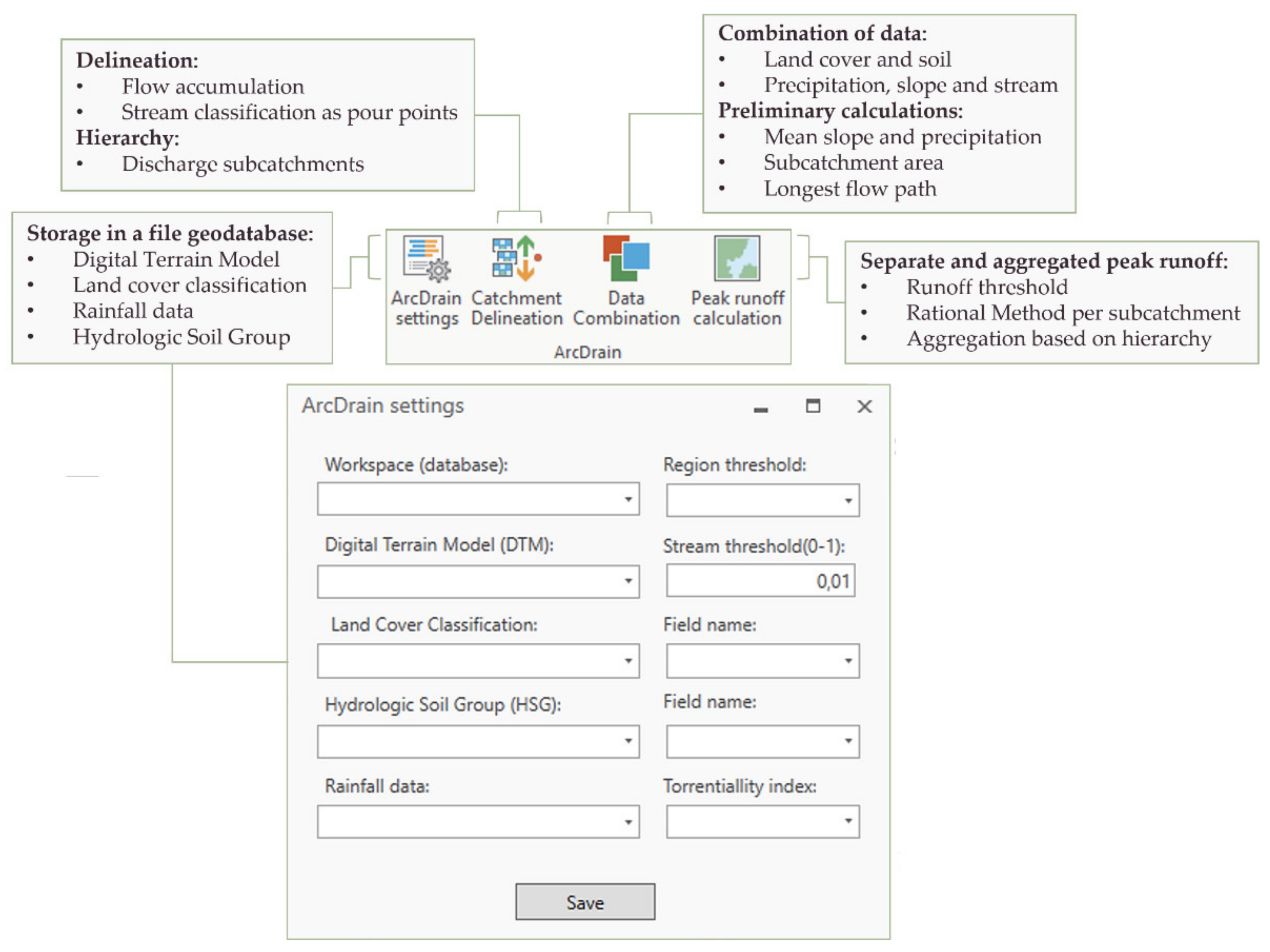
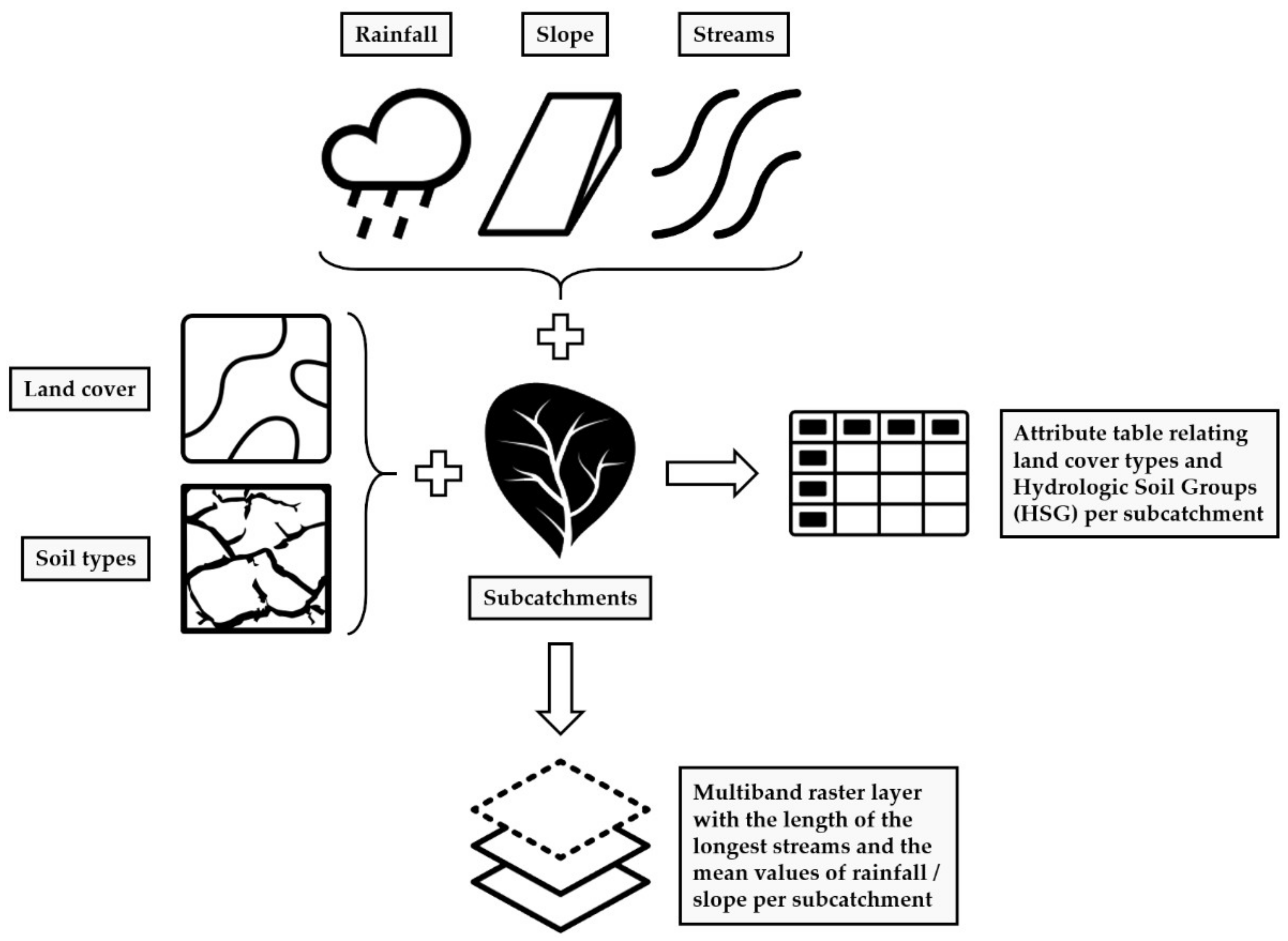
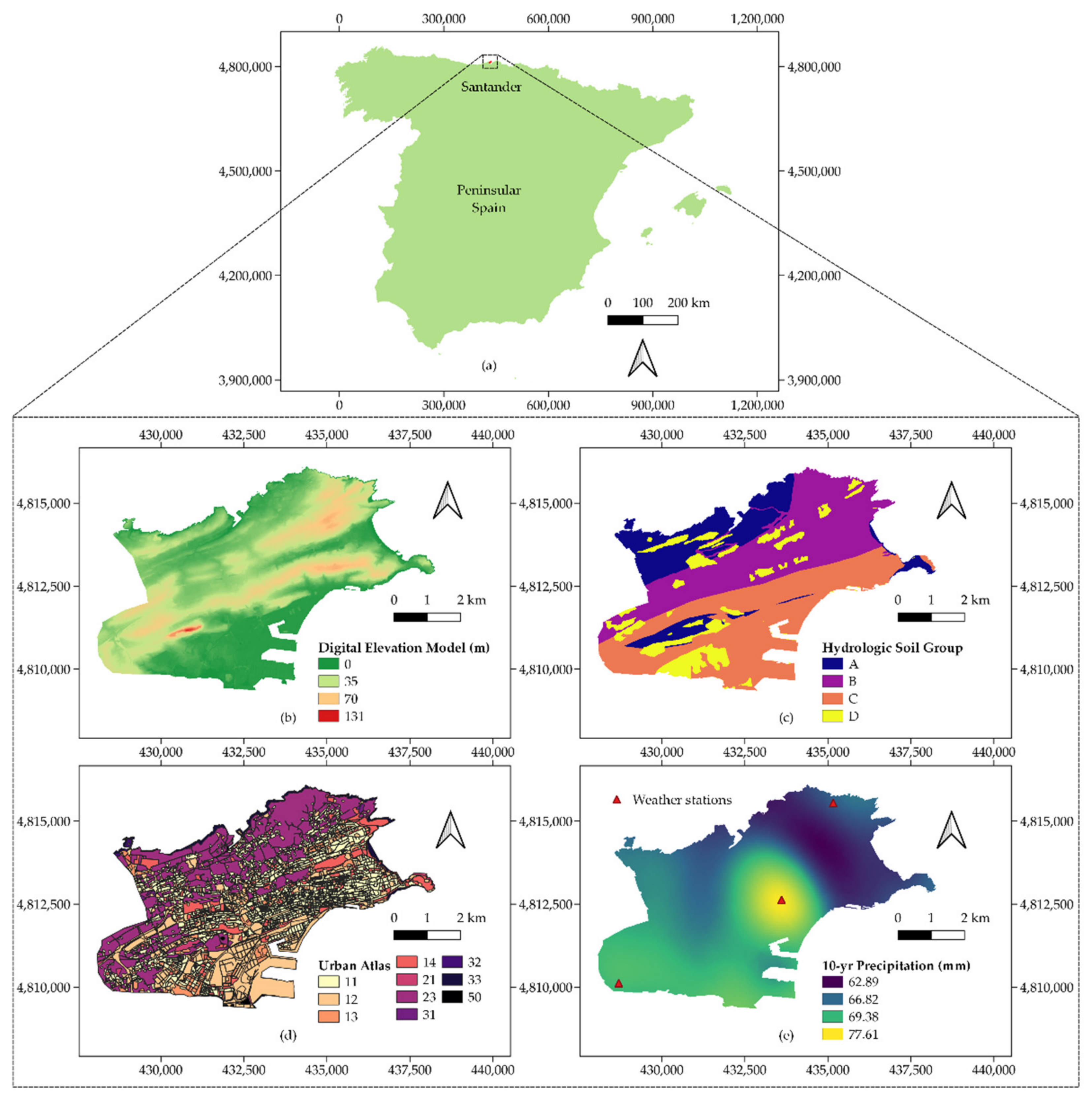
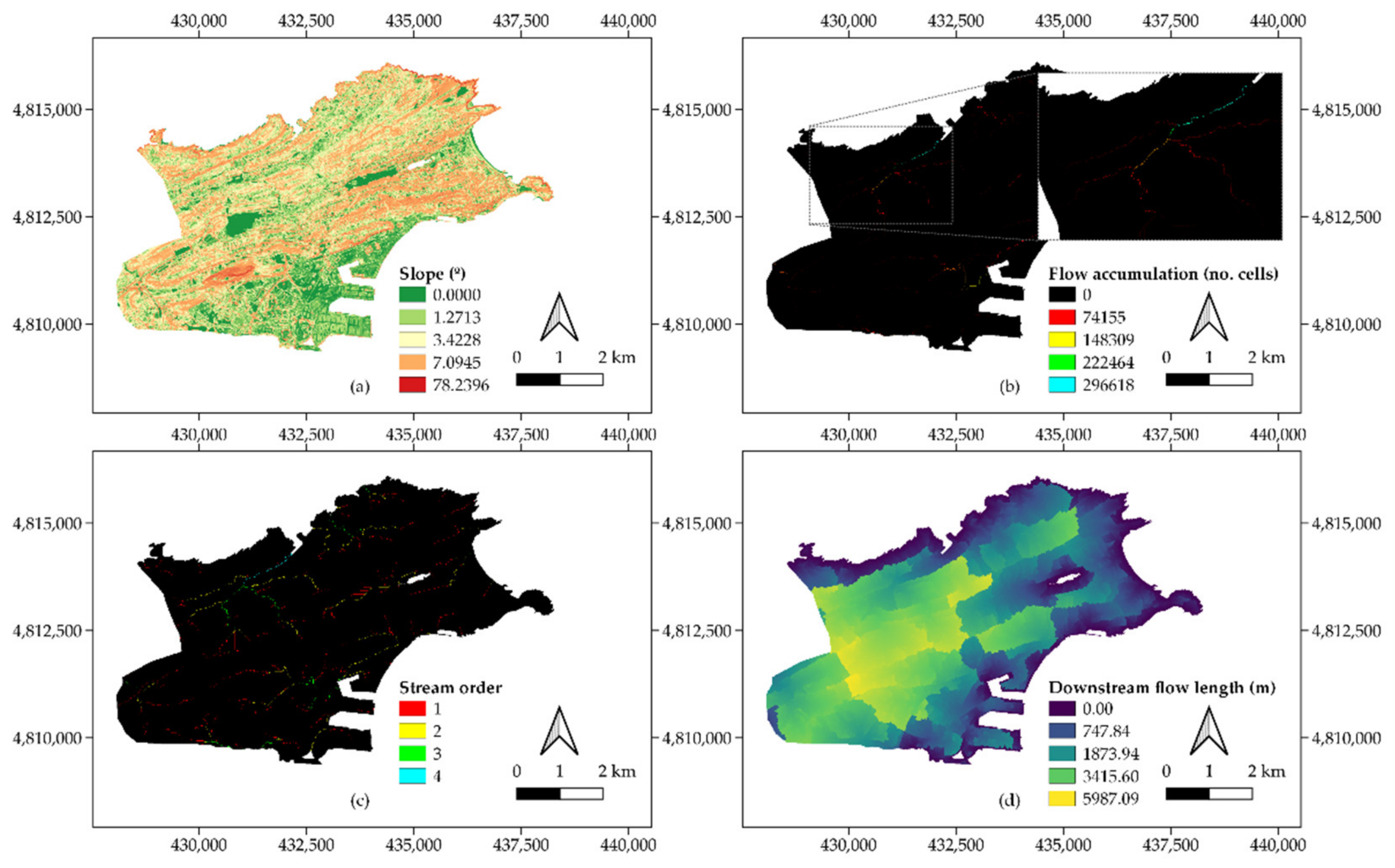

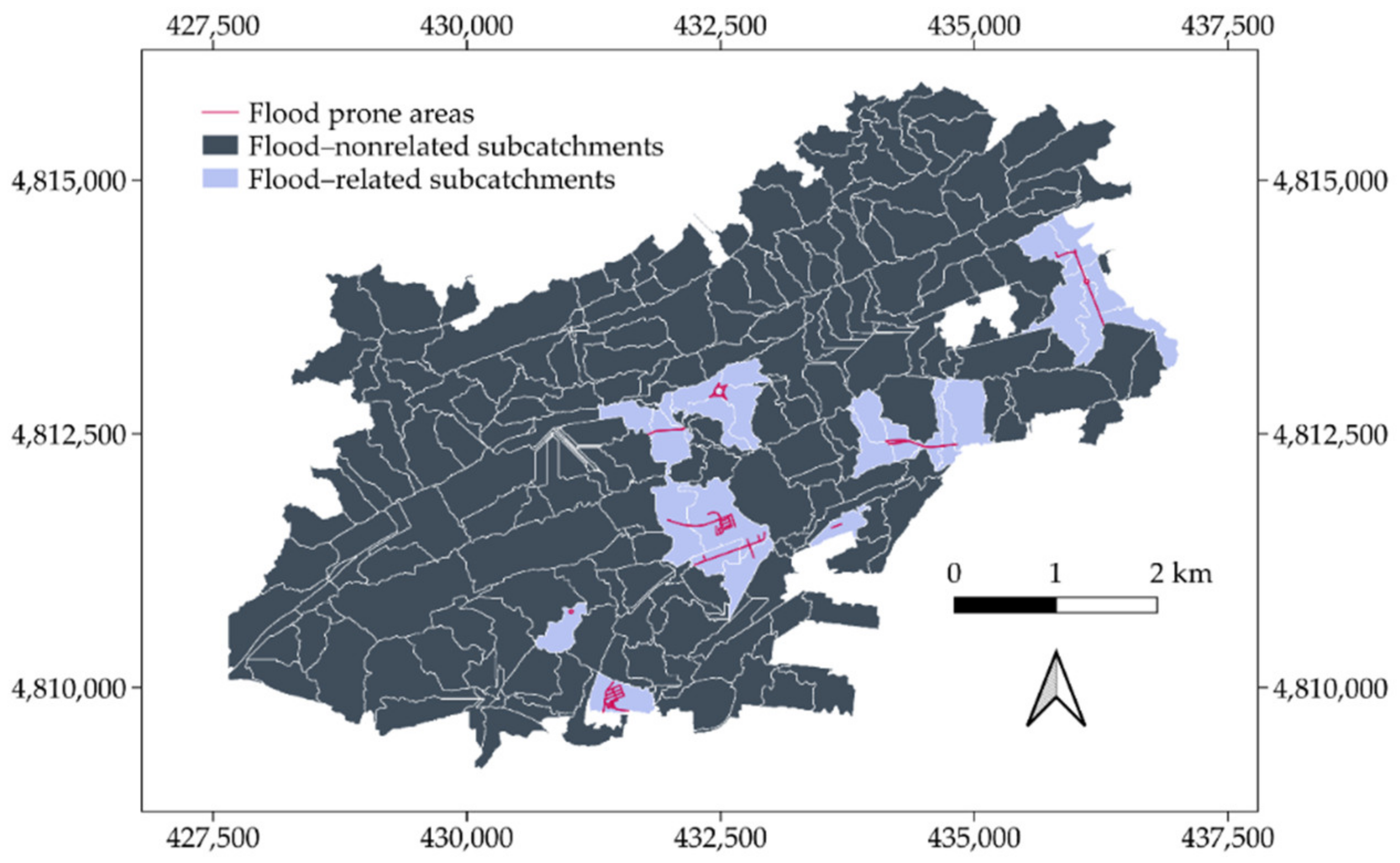
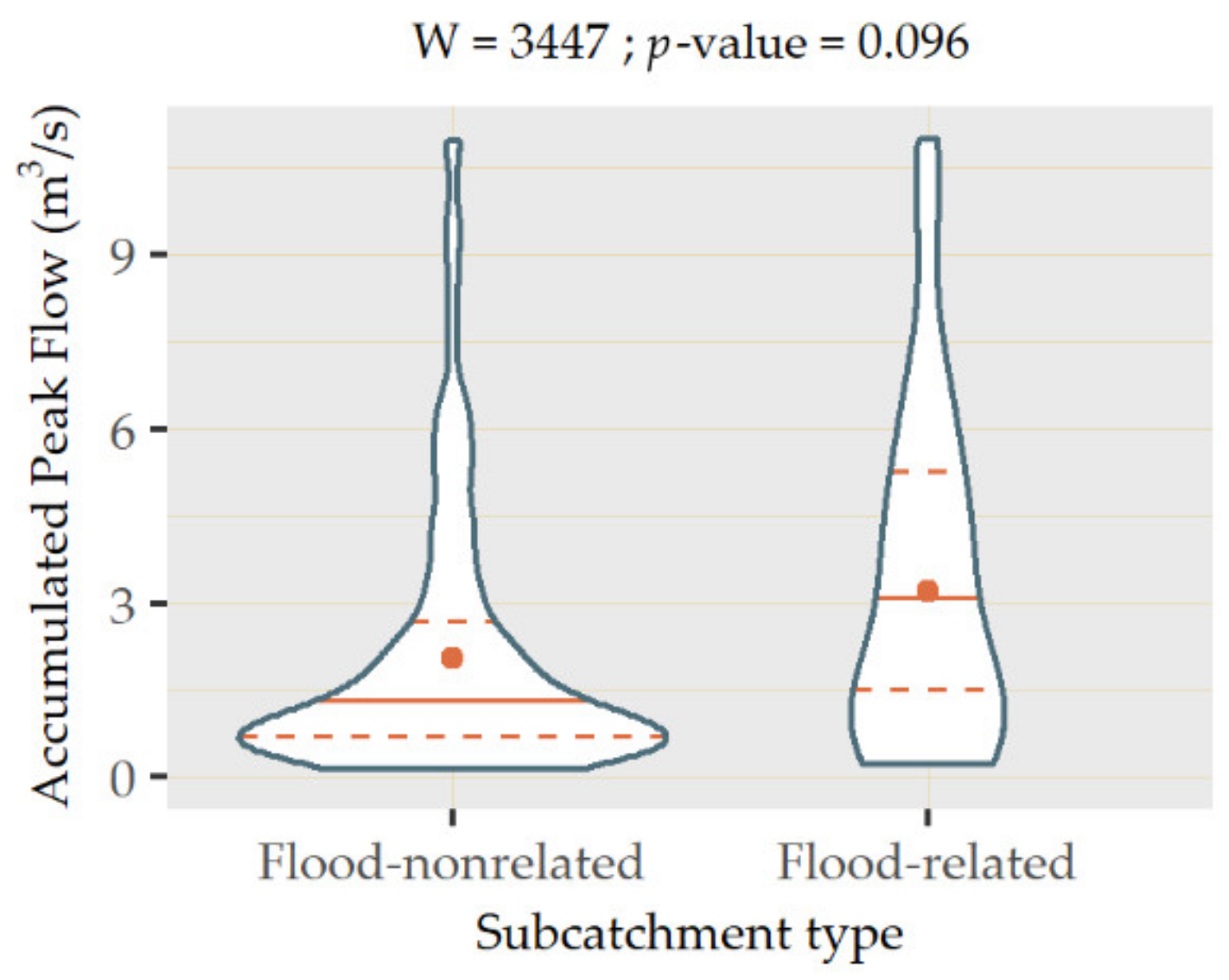
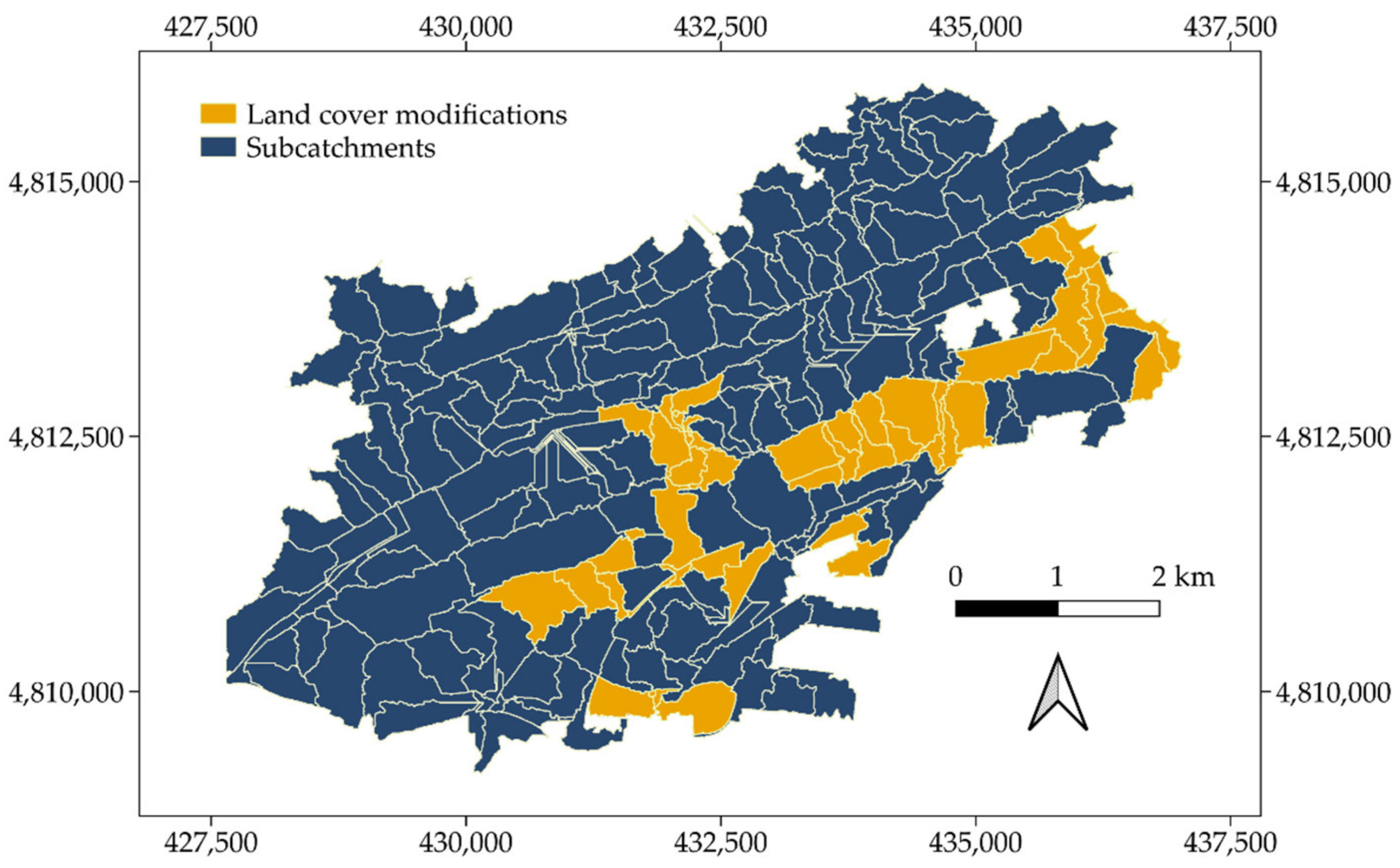
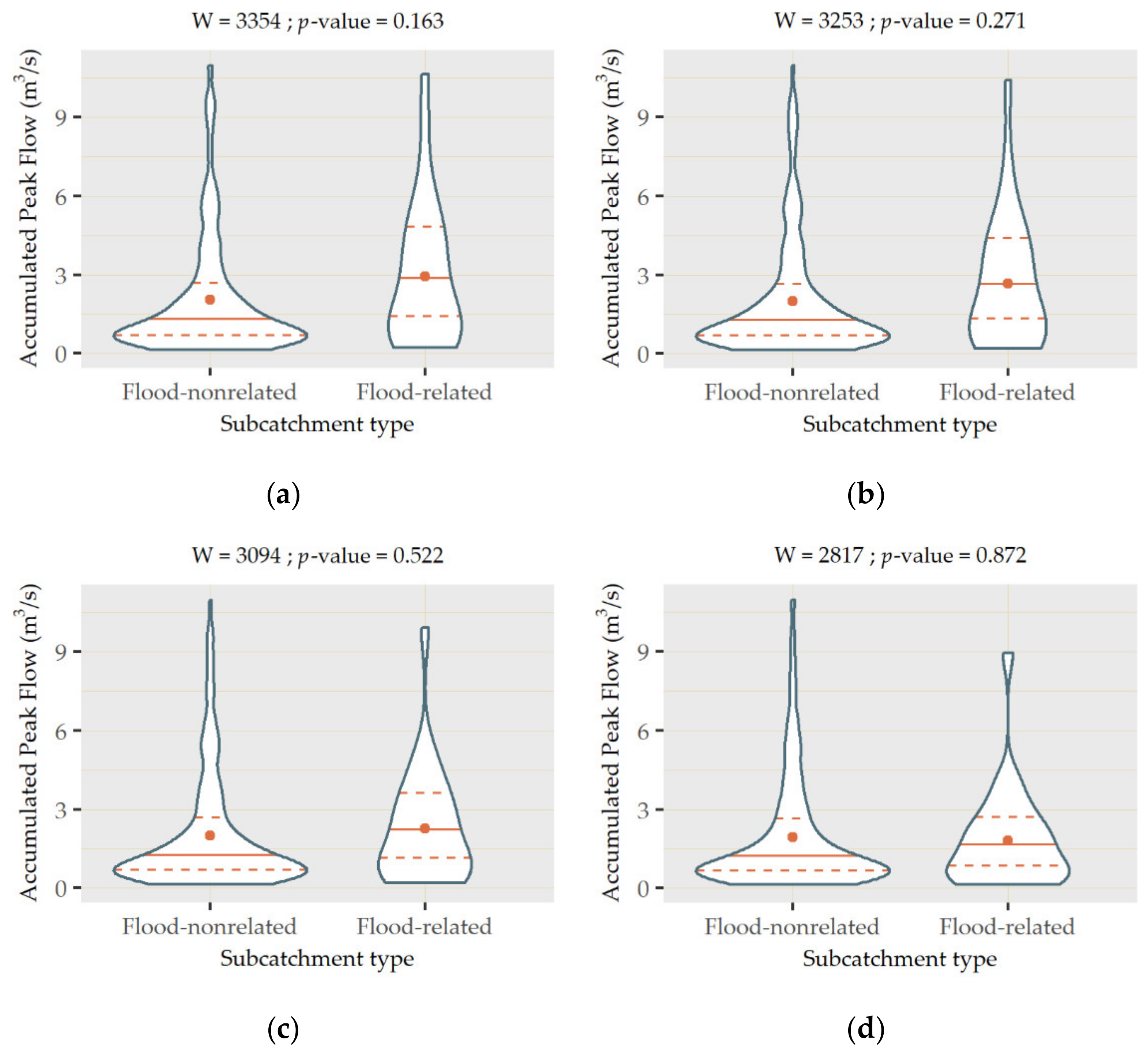
| Data | Type | Preparation |
|---|---|---|
| Digital elevation model | Grid | Clip to the limits of the study area |
| Land cover map | Polygon | Classification according to a 3-digit code |
| Hydrogeological map | Polygon | Classification based on runoff potential |
| Daily precipitation | Point | Calculation of extremes and interpolation |
| Code | Land Cover | Cropping Method | Slope (%) | Hydrologic Soil Group (HSG) | |||
|---|---|---|---|---|---|---|---|
| A | B | C | D | ||||
| 111 | Continuous urban fabric | - | - | 1 | 1 | 1 | 1 |
| 141 | Green urban areas | - | - | 53 | 23 | 14 | 10 |
| 212 | Irrigated herbaceous crops | S 1 | ≥3 | 37 | 20 | 12 | 9 |
| 212 | Irrigated herbaceous crops | C 2 | ≥3 | 42 | 23 | 14 | 11 |
| 212 | Irrigated herbaceous crops | S/C | <3 | 47 | 25 | 16 | 13 |
| 311 | Broad-leaved forest | - | - | 90 | 47 | 31 | 23 |
| 331 | Beaches and dunes | - | - | 152 | 152 | 152 | 152 |
| 412 | Peat bogs and meadows | - | - | 248 | 99 | 25 | 16 |
| 522 | Estuaries | - | - | 0 | 0 | 0 | 0 |
Publisher’s Note: MDPI stays neutral with regard to jurisdictional claims in published maps and institutional affiliations. |
© 2021 by the authors. Licensee MDPI, Basel, Switzerland. This article is an open access article distributed under the terms and conditions of the Creative Commons Attribution (CC BY) license (https://creativecommons.org/licenses/by/4.0/).
Share and Cite
Manchado, C.; Roldán-Valcarce, A.; Jato-Espino, D.; Andrés-Doménech, I. ArcDrain: A GIS Add-In for Automated Determination of Surface Runoff in Urban Catchments. Int. J. Environ. Res. Public Health 2021, 18, 8802. https://doi.org/10.3390/ijerph18168802
Manchado C, Roldán-Valcarce A, Jato-Espino D, Andrés-Doménech I. ArcDrain: A GIS Add-In for Automated Determination of Surface Runoff in Urban Catchments. International Journal of Environmental Research and Public Health. 2021; 18(16):8802. https://doi.org/10.3390/ijerph18168802
Chicago/Turabian StyleManchado, Cristina, Alejandro Roldán-Valcarce, Daniel Jato-Espino, and Ignacio Andrés-Doménech. 2021. "ArcDrain: A GIS Add-In for Automated Determination of Surface Runoff in Urban Catchments" International Journal of Environmental Research and Public Health 18, no. 16: 8802. https://doi.org/10.3390/ijerph18168802
APA StyleManchado, C., Roldán-Valcarce, A., Jato-Espino, D., & Andrés-Doménech, I. (2021). ArcDrain: A GIS Add-In for Automated Determination of Surface Runoff in Urban Catchments. International Journal of Environmental Research and Public Health, 18(16), 8802. https://doi.org/10.3390/ijerph18168802







